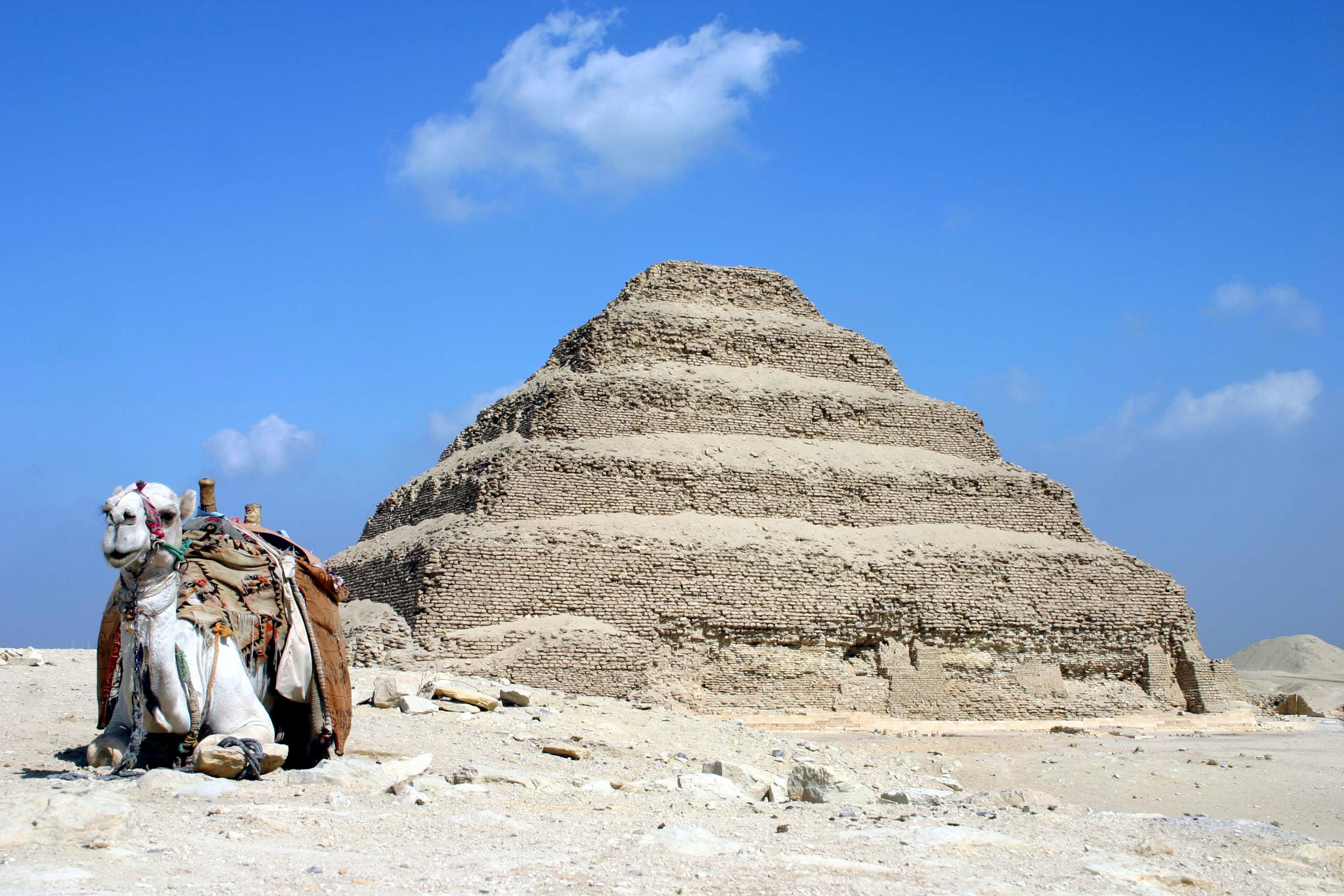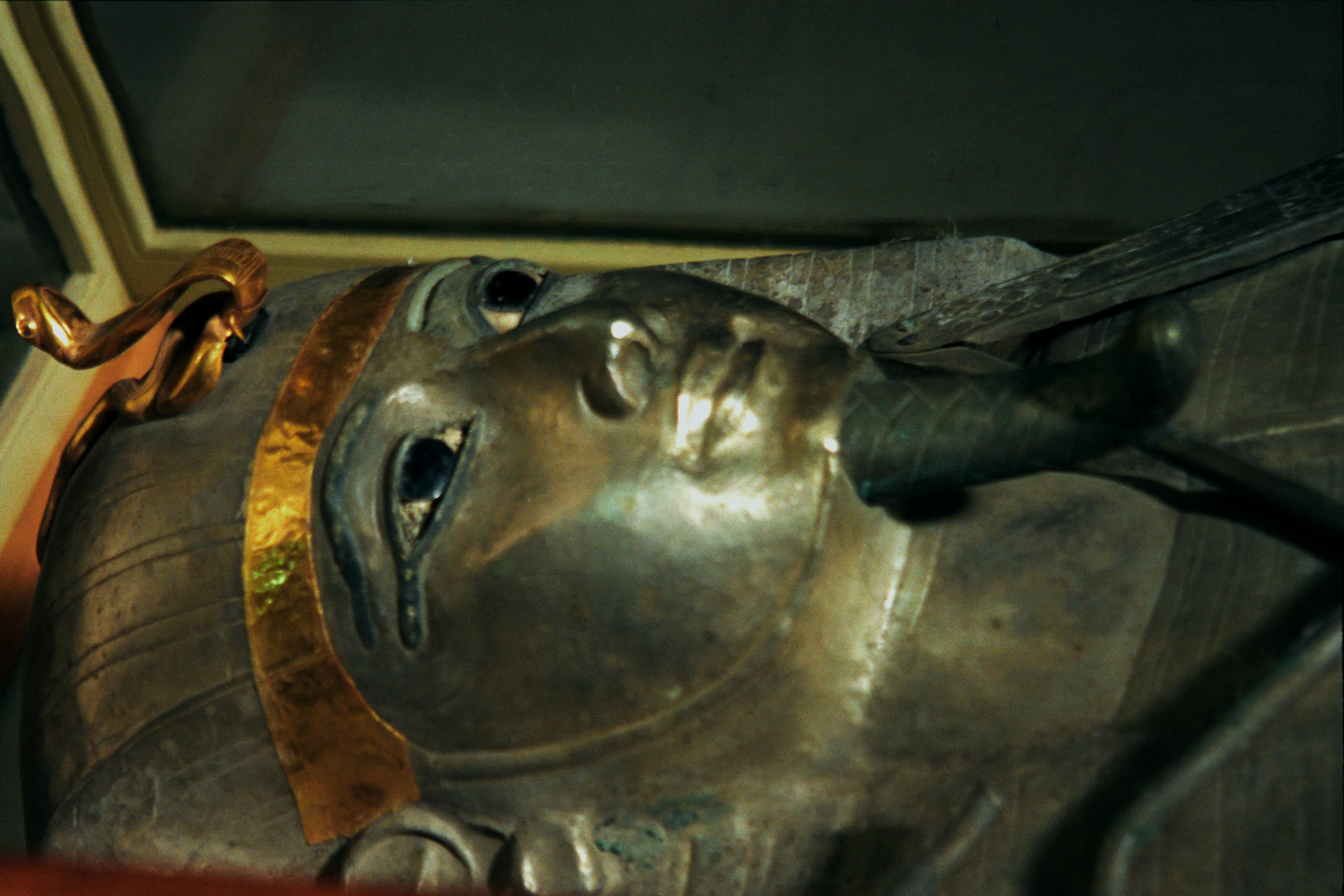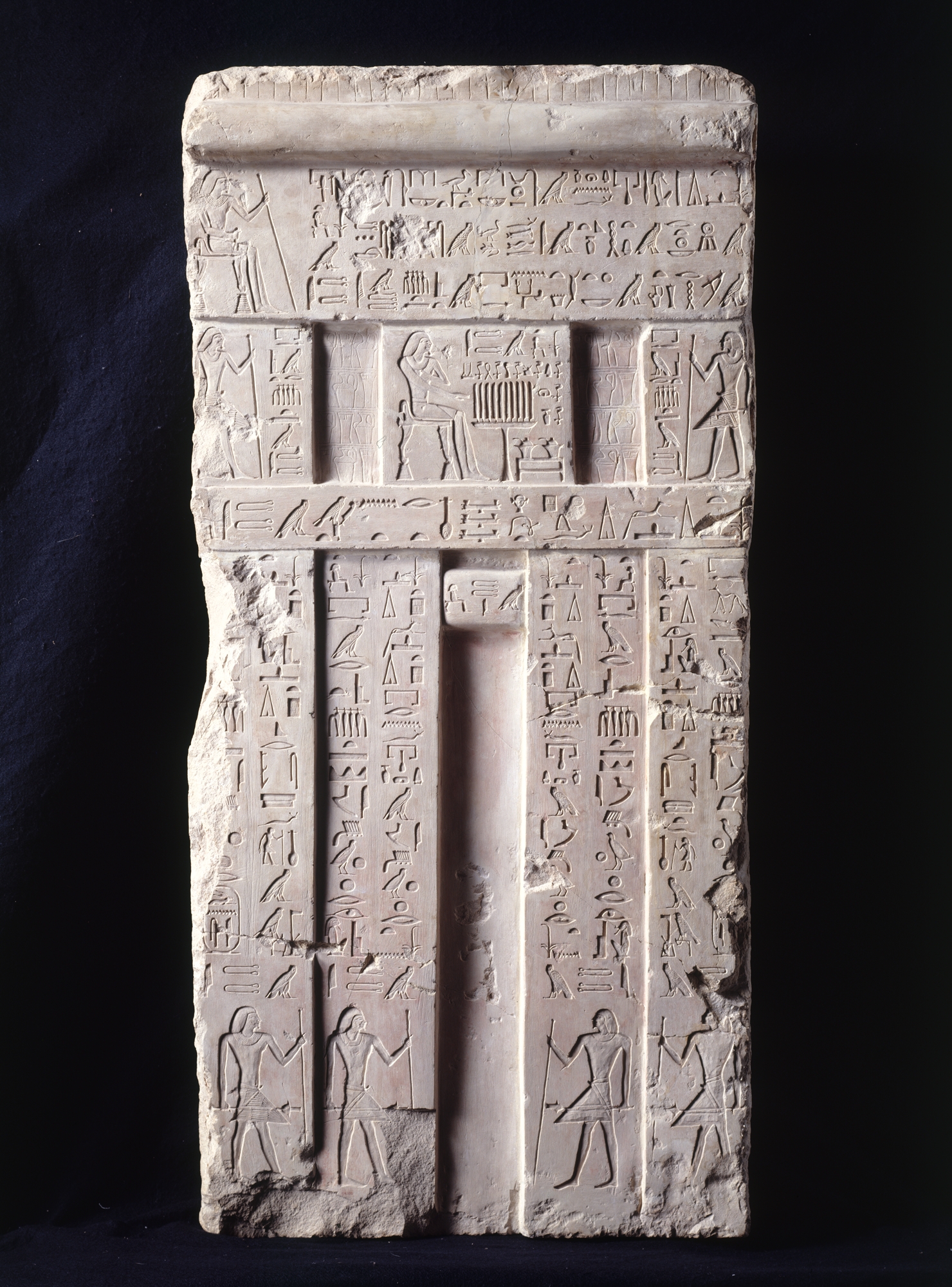|
Gisant
A tomb effigy ( French: ''gisant'' ("lying")) is a sculpted effigy of a deceased person usually shown lying recumbent on a rectangular slab, presented in full ceremonial dress or wrapped in a shroud, and shown either dying or shortly after death. Such funerary and commemorative reliefs were first developed in Ancient Egyptian and Etruscan cultures, and appear most frequently in Western European tombs from the late 11th century, in a style that continued in use through the Renaissance and early modern period, and is still sometimes used. They typically represent the deceased in a state of "eternal repose", with hands folded in prayer, lying on a pillow, awaiting resurrection. A husband and wife may be depicted lying side by side. Medieval life-size recumbent effigies were first used for tombs of royalty and senior clerics, before spreading to the nobility. A particular type of late medieval effigy was the ''transi'', or cadaver monument, in which the effigy is in the macabre fo ... [...More Info...] [...Related Items...] OR: [Wikipedia] [Google] [Baidu] |
Effigy
An effigy is a sculptural representation, often life-size, of a specific person or a prototypical figure. The term is mostly used for the makeshift dummies used for symbolic punishment in political protests and for the figures burned in certain traditions around New Year, Carnival and Easter. In European cultures, effigies were used in the past for punishment in formal justice when the perpetrator could not be apprehended, and in popular justice practices of social shaming and exclusion. Additionally, "effigy" is used for certain traditional forms of sculpture, namely tomb effigies, funeral effigies and coin effigies. There is a large overlap and exchange between the ephemeral forms of effigies. Traditional holiday effigies are often politically charged, for instance, when the generalised figures Año Viejo (the Old Year) or Judas in Latin America are substituted by the effigy of a despised politician. Traditional forms are also borrowed for political protests. In India, for i ... [...More Info...] [...Related Items...] OR: [Wikipedia] [Google] [Baidu] |
Cadaver Monument
A cadaver monument or ''transi'' is a type of funerary art, funerary monument to a deceased person, featuring a sculpted tomb effigy of a skeleton, or of an emaciated or decomposing dead body, with closed eyes. It was particularly characteristic of the Late Middle Ages when they were designed as a to remind viewers of the transience and vanity of mortal life compared to the eternity and desirability of the Christian after-life. The format is in stark contrast to gisants, which are always recumbent, in full dress, with open eyes and hands clasped and raised in prayer.Cohen (1974), p. 9Covi (1975), p. 385 Cadaver monuments first appeared in the 1380s and remained a popular form of funerary art for 200 subsequent years.Heimerman (2021), p. 3 In a still widely debated theory popularized by the historians Helen M. Roe and John Aberth,Heimerman (2021), p. 7 cadaver monuments are often interpreted as a form of ''memento mori'' or adaption of the motif of "The Three Living and the Three ... [...More Info...] [...Related Items...] OR: [Wikipedia] [Google] [Baidu] |
Pleurants
Pleurants or weepers (the English meaning of ''pleurants'') are anonymous sculpted figures representing mourners, used to decorate elaborate tomb monuments, mostly in the late Middle Ages in Western Europe. Typically they are relatively small, and a group were placed around the sides of a raised tomb monument, perhaps interspersed with armorial decoration, or carrying shields with this. They may be in relief or free-standing. In English usage the term "weepers" is sometimes extended to cover the small figures of the deceased's children often seen kneeling underneath the tomb effigy in Tudor tomb monuments. These figures represent the mourners, who pray for the deceased standing during the funeral procession.Stone, 146 Because many of the original tombs have been vandalised or destroyed, relatively few examples remain to be studied. Many figures have been detached from their original context, which is not always known. In the 16th and 17th century the practice of placing anony ... [...More Info...] [...Related Items...] OR: [Wikipedia] [Google] [Baidu] |
Funerary Art
Funerary art is any work of art forming, or placed in, a repository for the remains of the death, dead. The term encompasses a wide variety of forms, including cenotaphs ("empty tombs"), tomb-like monuments which do not contain human remains, and communal memorials to the dead, such as war memorials, which may or may not contain remains, and a range of prehistoric megalithic constructs. Funerary art may serve many cultural functions. It can play a role in burial rites, serve as an article for use by the dead in the afterlife, and celebrate the life and accomplishments of the dead, whether as part of kinship-centred practices of ancestor veneration or as a publicly directed Dynasty, dynastic display. It can also function as a reminder of the mortality of humankind, as an expression of cultural values and roles, and help to propitiate the spirits of the dead, maintaining their benevolence and preventing their unwelcome intrusion into the lives of the living. The deposit of object ... [...More Info...] [...Related Items...] OR: [Wikipedia] [Google] [Baidu] |
Henri II Catherine De Médicis Pilon
Henri is the French form of the masculine given name Henry (given name), Henry, also in Estonian, Finnish, German and Luxembourgish. Bearers of the given name include: People French nobles * Henri I de Montmorency (1534–1614), Marshal and Constable of France * Henri I, Duke of Nemours (1572–1632), the son of Jacques of Savoy and Anna d'Este * Henri II, Duke of Nemours (1625–1659), the seventh Duc de Nemours * Henri, Count of Harcourt (1601–1666), French nobleman * Henri, Dauphin of Viennois (1296–1349), bishop of Metz * Henri de Gondi (other) * Henri de La Tour d'Auvergne, Duke of Bouillon (1555–1623), member of the powerful House of La Tour d'Auvergne * Henri Emmanuel Boileau, baron de Castelnau (1857–1923), French mountain climber * Henri, Grand Duke of Luxembourg (born 1955), the head of state of Luxembourg * Henri de Massue, Earl of Galway (1648–1720), French Huguenot soldier and diplomat, one of the principal commanders of Battle of Almansa * Françoi ... [...More Info...] [...Related Items...] OR: [Wikipedia] [Google] [Baidu] |
Fayum Mummy Portraits
Mummy portraits or Fayum mummy portraits are a type of naturalistic painted portrait on wooden boards attached to upper class mummies from Roman Egypt. They belong to the tradition of panel painting, one of the most highly regarded forms of art in the Classical world. The Fayum portraits are the only large body of art from that tradition to have survived. They were formerly, and incorrectly, called Coptic portraits. Mummy portraits have been found across Egypt, but are most common in the Faiyum Basin, particularly from Hawara and the Hadrianic Roman city Antinoopolis. "Faiyum portraits" is generally used as a stylistic, rather than a geographic, description. While painted cartonnage mummy cases date back to pharaonic times, the Faiyum mummy portraits were an innovation dating to the time of Roman rule in Egypt. The portraits date to the Imperial Roman era, from the late 1st century BC or the early 1st century AD onwards. It is not clear when their production ended, but ... [...More Info...] [...Related Items...] OR: [Wikipedia] [Google] [Baidu] |
Pyramid Of Djoser
The pyramid of Djoser, sometimes called the Step Pyramid of Djoser or Step Pyramid of Horus Netjerikhet, is an archaeological site in the Saqqara necropolis, Egypt, northwest of the ruins of Memphis.Bard, Kathryn A., and Jean-Philipee Lauer, eds. 1999. "Saqqara, pyramids of the 3rd Dynasty" ''Encyclopedia of the Archaeology of Ancient Egypt''. London: Routledge. 859 It is the first Egyptian pyramid to be built. The 6-tier, 4-sided structure is the earliest colossal stone building in Egypt. It was built in the 27th century BC during the Third Dynasty for the burial of Pharaoh Djoser. The pyramid is the central feature of a vast mortuary complex in an enormous courtyard surrounded by ceremonial structures and decoration. The pyramid went through several revisions and redevelopments of the original plan. The pyramid originally stood tall, with a base of and was clad in polished white limestone. As of 1997 the step pyramid (or proto-pyramid) was considered to be the earliest ... [...More Info...] [...Related Items...] OR: [Wikipedia] [Google] [Baidu] |
Tutankhamun
Tutankhamun or Tutankhamen, (; ), was an Egyptian pharaoh who ruled during the late Eighteenth Dynasty of Egypt, Eighteenth Dynasty of ancient Egypt. Born Tutankhaten, he instituted the restoration of the traditional polytheistic form of ancient Egyptian religion, undoing a previous shift to the religion known as Atenism. Tutankhamun's reign is considered one of the greatest restoration periods in ancient Egyptian history. His endowments and restorations of cults were recorded on what is today known as the Restoration Stela. The cult of the god Amun at Thebes, Egypt, Thebes was restored to prominence, and the royal couple changed their names to "Tutankhamun" and "Ankhesenamun", replacing the -aten suffix. He also moved the royal court from Akhenaten's capital, Amarna, back to Memphis, Egypt, Memphis almost immediately on his accession to the kingship. He reestablished diplomatic relations with the Mitanni and carried out military campaigns in Nubia and the Near East. Tutankh ... [...More Info...] [...Related Items...] OR: [Wikipedia] [Google] [Baidu] |
Psusennes I
Psusennes I (; Greek Ψουσέννης) was the third pharaoh of the 21st Dynasty who ruled from Tanis between 1047 and 1001 BC. ''Psusennes'' is the Greek version of his original name Pasibkhanu or Pasebakhaenniut (in reconstructed Late Egyptian: /pəsiwʃeʕənneːʔə/), which means "The Star Appearing in the City" while his throne name, Akheperre Setepenamun, translates as "Great are the Manifestations of Ra, chosen of Amun." He was the son of Pinedjem I and Henuttawy, Ramesses XI's daughter by Tentamun. He married his sister Mutnedjmet. Psusennes's tomb, discovered in February 1940 by the French Egyptologist Pierre Montet, is notable for the condition in which it was found. All previously found pharaonic tombs had been graverobbed, including the tomb of Tutankhamun, and Psusennes's tomb was the only ancient Egyptian royal tomb discovered in fully intact condition. However, the humid climate of Lower Egypt meant only the metal objects had survived. Pharaoh Amenemope and ... [...More Info...] [...Related Items...] OR: [Wikipedia] [Google] [Baidu] |
Fayum
Faiyum ( ; , ) is a city in Middle Egypt. Located southwest of Cairo, in the Faiyum Oasis, it is the capital of the modern Faiyum Governorate. It is one of Egypt's oldest cities due to its strategic location. Name and etymology Originally founded by the ancient Egyptians as Shedet, its current name in English is also spelled as Fayum, Faiyum or al-Faiyūm. Faiyum was also previously officially named Madīnat al-Faiyūm (Arabic for ''The City of Faiyum''). The name Faiyum (and its spelling variations) may also refer to the Faiyum Oasis, although it is commonly used by Egyptians today to refer to the city. The modern name of the city comes from Coptic / ' (whence also the personal name '), meaning ''the Sea'' or ''the Lake'', which in turn comes from late Egyptian ''pꜣ-ym'' of the same meaning, a reference to the nearby Lake Moeris; the extinct elephant ancestor '' Phiomia'' was named after it. Ancient history Archaeological evidence has found occupations around ... [...More Info...] [...Related Items...] OR: [Wikipedia] [Google] [Baidu] |
Hawara
Hawara is an archaeological site of Ancient Egypt, south of the site of Crocodilopolis ('Arsinoë', also known as 'Medinet al-Faiyum') at the entrance to the depression of the Fayyum oasis. It is the site of a pyramid built by Pharaoh Amenemhat III of the 12th dynasty in the 19th century B.C. History Amenemhat III was the last powerful ruler of the 12th Dynasty, and the pyramid he built at Hawara is believed to post-date the so-called "Black Pyramid" built by the same ruler at Dahshur. This is believed to have been Amenemhat's final resting place. At Hawara there was also the intact (pyramid) tomb of Neferuptah, daughter of Amenemhat III. This tomb was found about 2 km south of the king's pyramid. In common with the Middle Kingdom pyramids constructed after Amenemhat II, it was built of mudbrick round a core of limestone passages and burial chambers, and faced with limestone. Most of the facing stone was later pillaged for use in other buildings— a fate common t ... [...More Info...] [...Related Items...] OR: [Wikipedia] [Google] [Baidu] |
Old Kingdom Of Egypt
In ancient Egyptian history, the Old Kingdom is the period spanning –2200 BC. It is also known as the "Age of the Pyramids" or the "Age of the Pyramid Builders", as it encompasses the reigns of the great pyramid-builders of the Fourth Dynasty of Egypt, Fourth Dynasty, such as King Sneferu, under whom the art of pyramid-building was perfected, and the kings Khufu, Khafre and Menkaure, who commissioned the construction of the Giza pyramid complex, pyramids at Giza. Ancient Egypt, Egypt attained its first sustained peak of civilization during the Old Kingdom, the first of three so-called "Kingdom" Egyptian chronology, periods (followed by the Middle Kingdom of Egypt, Middle Kingdom and New Kingdom of Egypt, New Kingdom), which mark the high points of civilization in the lower Nile Valley. The Periodization of Ancient Egypt, concept of an "Old Kingdom" as one of three "golden ages" was coined in 1845 by the German Egyptology, Egyptologist Christian Charles Josias von Bunsen, Baron ... [...More Info...] [...Related Items...] OR: [Wikipedia] [Google] [Baidu] |




